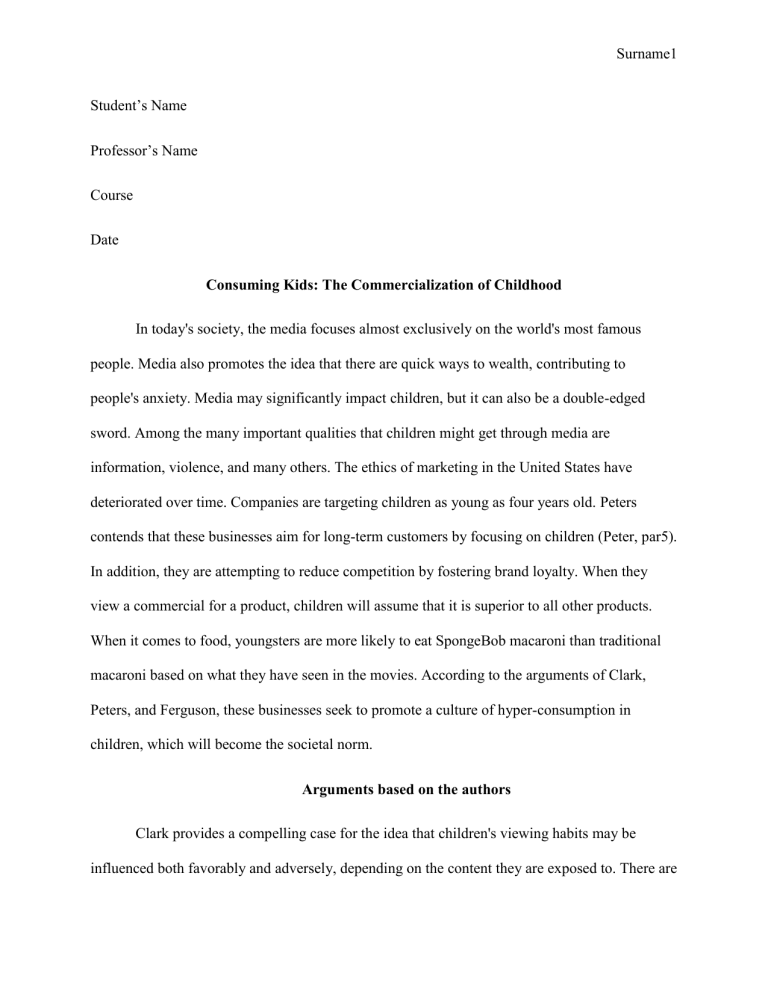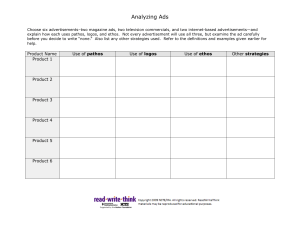
Surname1 Student’s Name Professor’s Name Course Date Consuming Kids: The Commercialization of Childhood In today's society, the media focuses almost exclusively on the world's most famous people. Media also promotes the idea that there are quick ways to wealth, contributing to people's anxiety. Media may significantly impact children, but it can also be a double-edged sword. Among the many important qualities that children might get through media are information, violence, and many others. The ethics of marketing in the United States have deteriorated over time. Companies are targeting children as young as four years old. Peters contends that these businesses aim for long-term customers by focusing on children (Peter, par5). In addition, they are attempting to reduce competition by fostering brand loyalty. When they view a commercial for a product, children will assume that it is superior to all other products. When it comes to food, youngsters are more likely to eat SpongeBob macaroni than traditional macaroni based on what they have seen in the movies. According to the arguments of Clark, Peters, and Ferguson, these businesses seek to promote a culture of hyper-consumption in children, which will become the societal norm. Arguments based on the authors Clark provides a compelling case for the idea that children's viewing habits may be influenced both favorably and adversely, depending on the content they are exposed to. There are Surname2 several ways in which today's children are being marketed as customers. Their advertising is plastered on almost every surface. When kids turn on the television, the bus radio, or the internet, they encounter advertisements (Clark, par 2). According to him, since the introduction of more sophisticated forms of media to the American population, the media's effect on children has risen. Preparation for school, intellectual enrichment, exposure to social concerns, and the arts via music and performance are just a few of the advantages of these events. On the other hand, sensationalizing violent conduct, exposing children to explicit or implicit sexual material, promoting unrealistic body views, and promoting unhealthy lifestyles as attractive may all have negative consequences. Similarly, according to Peter's perspective, new marketing has changed our society by making us shallower. Using Peter's example, we can see how children have been targeted as a market sector in the past, but now they are being trained from birth to become super-consumers (Peter, par 5). Many reasons have contributed to the rise in corporate marketing to youngsters. As a result of deregulation of the ad business that occurred in the 1980s, there were fewer limits on advertising to children, which led to an expansion in cable television and the promotion of "corporate kid culture." Unfortunately, this is a poor lesson for youngsters since money can't purchase happiness. As a result, an increase in mental health concerns may be expected due to young people pursuing financial success rather than their life's purpose. Ferguson backs up both Clark and Peter’s argument by effectively stating that deceptive marketing used deceptive promises of advantages and financial responsibilities to lure children and encourage them to buy (Ferguson, par 8). Children learn by watching and mimicking what they see on television and other media by observing, imitating, and developing their own or similar actions. Children are constantly being told what kind of appearance they should and Surname3 shouldn't have via many forms of media. To avoid damaging their self-esteem, they are compelled to behave and organize themselves in ways they would rather not. The author's purpose and how they achieve it For Clark, the purpose is to show how media can impact children's lives. It worked for him because he demonstrated how media has a significant influence on our children's everyday life, but excessive use of social media may lead to negative consequences; thus, parents must be present to use social media. While violence itself is essential, context plays a significant role in whether or not students learn about violence or become violent themselves (Clark, par 15). However, keeping this essential caution in heart and considering the data presented, it can be concluded from the previous research that media violence affects children negatively and is associated with their tendency toward violent conduct. In the same way, Peters' purpose was to demonstrate how rapidly changing economic and technological trends are transforming children's experiences throughout the globe. He achieved his goal by showing that children's interactions with family and friends had gotten entwined with consumerism (Peters, par 8). According to his example, mental and physical health are significant concerns in today's culture. Fast food and sedentary behavior are being promoted to children, increasing childhood obesity. It is more critical to watch television and consume fast food all day. Also, for Ferguson, the purpose was to highlight how advertising influences our children's conduct. By targeting young people, he says, unethical advertising has a more significant impact on the public (Ferguson, par11). Adverts are now readily accessible to all kinds of customers, including youngsters, thanks to the digitalization of advertising. Ads Surname4 targeting children are immoral, regardless of whether they are done knowingly or not, since the line between deceit and honest commercial conduct is blurred when it comes to exploiting children's growing cognitive processes, as he demonstrated convincingly. Use of rhetoric appeals by the author The authors revealed that the main attribute to have is connecting with their audience. These authors used rhetorical appeals to make these connections. When it came to engaging and influencing their audience, the author made excellent use of rhetorical arguments in their article. In addition, they employed ethos, logos, and pathos in their pleas. In their article, the writers used all of the attractions to their best advantage, and each one had a specific purpose. They all worked together to help the authors succeed in their purpose. To persuade the audience, Clark, for example, used ethos. For his argument, he turns to research from the American Academy of Pediatrics, which claims that children learn through imitation rather than direct indoctrination from the media. He also employs logos, a rhetorical strategy that relies on logic and evidence to persuade the listeners. That's what he was trying to show, and it's becoming more prevalent in the media. For example, tobacco and alcohol companies spend $6 billion and $2 billion, respectively, each year on advertising that targets minors (Clark, par22). Lastly, he used pathos by evoking an emotional reaction and indicating that parents and other concerned adults were worried about children's exposure to ageinappropriate information and its possible detrimental repercussions. Similarly, as Peters noted out using ethos, children's connections with their families and friends seem to be intricately linked to their consumption of goods. He also used logos to convince his audience, arguing that various studies have explored the relationship between Surname5 children's media consumption and the impact of growing exposure to consumer culture on their well-being (Peters, par 7). Also, pathos is used by saying that youngsters said they didn't have as much time with their parents who felt forced to work long hours because of their emotional reaction. Lastly, as Ferguson points out, commercials are problematic on several levels. He uses ethos to demonstrate this. By asserting that advertising is a sort of marketing in which the product and its advantages (or the stated benefits) are proclaimed via numerous media channels, the author utilizes logos to convince the audience (Ferguson, par3). He also uses pathos to elicit an emotional reaction by saying that marketing to children, especially young children, works through pester power. The family gave in to children who ride them for a specific product. In conclusion, in today's world, children are often used to generate revenue. It seems as though everything is being utilized to promote their products. When children use the television, the bus radio, or the internet, they will be exposed to commercials. Schoolchildren are bombarded with gaming advertisements. Toys from a popular television program are being sold with meals at restaurants to target children. As a result, it is difficult for parents to regularly monitor what their children consume. Therefore, many resources are devoted to pursuing the most effective forms of advertising. Surname6 Works cited Clark, Laura. B. Media, Influence on Children. 2002. Encyclopedia of Education (Vol. 5. 2nd Ed.). Ferguson, Christopher. Advertising Effects. 2015. The Psych 101 Series: Media Psychology 101 Peters, Michael. Childhood and Globalization. Encyclopedia of Educational Philosophy and Theory.



